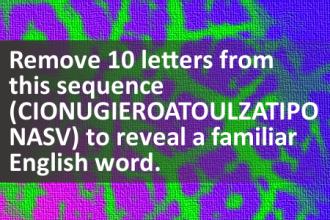Remove 10 letters from this ...
Remove 10 letters from this sequence (CIONUGIEROATOULZATIPONASV) to reveal a familiar English word.Correct answers: 76
The first user who solved this task is Djordje Timotijevic.
#brainteasers #wordpuzzles

Dancing Duck
A circus owner walked into a bar to see everyone crowded about a table watching a little show. On the table was an upside down pot and a duck tap dancing on it. The circus owner was so impressed that he offered to buy the duck from its owner. After some wheeling and dealing, they settled for $10,000 for the duck and the pot.
Three days later the circus owner runs back to the bar in anger, "Your duck is a ripoff! I put him on the pot before a whole audience, and he didn't dance a single step!"
"So?" asked the ducks former owner, "did you remember to light the candle under the pot?"

